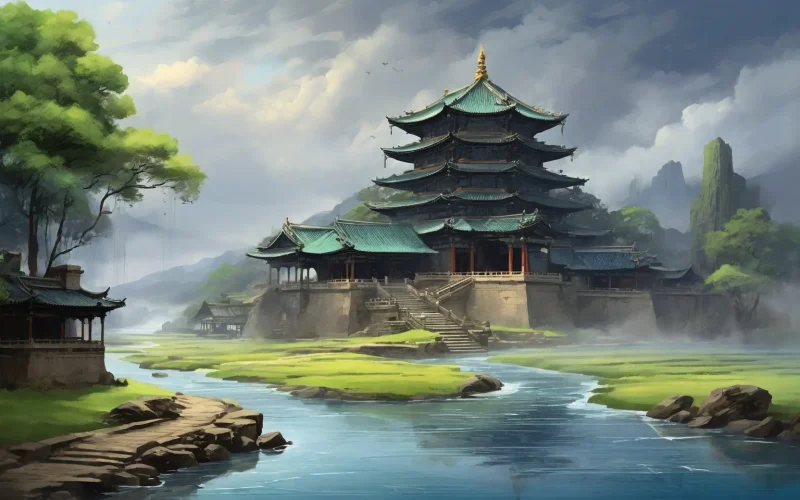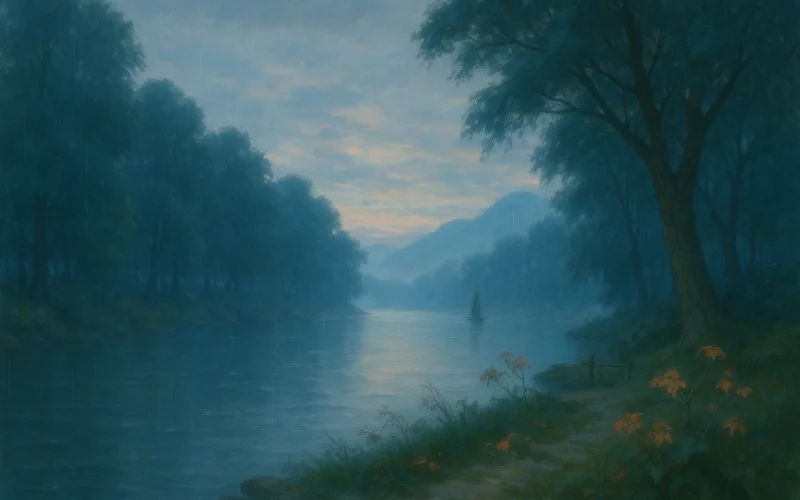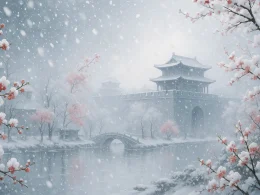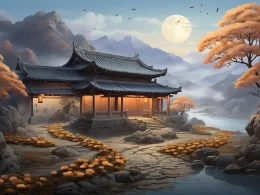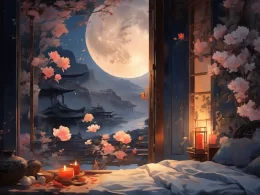The wind sweeps fallen blooms and young leaves away,
Leaving sparse stalls and lonely towers grey.
Fine rain and gulls in flight—
All gather in parted hearts’ night.
Each fair spring finds me ill, year after year,
I drift west—water flows east, crystal-clear.
The stream bears no grief like withered flowers,
Carrying sorrow not for hours.
Original Poem
「采桑子 · 乱红夭绿风吹尽」
乱红夭绿风吹尽,小市疏楼。
细雨轻鸥。总向离人恨里收。年年春好年年病,妾自西游。
吕本中
水自东流。不似残花一样愁。
Interpretation
Composed during Lü Benzhong's years of political exile and chronic illness, this lyric distills Southern Song melancholy into sparse springscape imagery. Written while drifting between postings, it captures the scholar-official's quintessential dilemma: nature's cyclical renewal versus human frailty and displacement. The poem's power lies in its restraint—using withered greens and eastward waters to mirror dynastic decline and personal resignation.
First Stanza: "夭绿风吹尽,小市疏楼。细雨轻鸥。总向离人恨里收。"
Yāo lǜ fēng chuī jìn, xiǎo shì shū lóu. Xì yǔ qīng ōu. Zǒng xiàng lí rén hèn lǐ shōu.
Tender greens withered by wind's last blow,
market stalls sparse, towers skeletal.
Fine rain—a lone gull's glide—
all swallowed by the wanderer's grief.
The stanza opens with nature's retreat: "tender greens" (夭绿), emblematic of spring's vitality, succumb to the wind. The "skeletal towers" (疏楼) stand as stark counterpoints to what should be bustling spring markets. Even the delicate "gull in fine rain" (细雨轻鸥)—traditionally a symbol of freedom—becomes trapped in the observer's melancholy.
Second Stanza: "年年春好年年病,妾自西游。水自东流。不似残花一样愁。"
Nián nián chūn hǎo nián nián bìng, qiè zì xī yóu. Shuǐ zì dōng liú. Bù sì cán huā yīyàng chóu.
Each year spring shines, each year I ail,
"this humble traveler" westward bound.
Waters rush east—
my sorrow's not like fading blossoms'.
Here, parallelism sharpens the paradox: "spring shines/I ail" (春好/病) mirrors the irreconcilable—nature's persistence versus human decline. The self-deprecating "humble traveler" (妾自西游) carries layered irony, referencing both Confucian exile tropes and a Daoist sage's detachment. Most striking is the final twist: while blossoms decay completely, the poet claims his grief transcends such ephemerality—a defiant whisper of enduring consciousness amid flux.
Holistic Appreciation
This lyric masters the Song-era art of compression. The first stanza's decaying springscape (withered greens, skeletal towers) externalizes displacement; the gull—typically free—here mirrors the observer's trapped gaze. The second stanza's structural chiasmus ("spring shines/I ail" vs. "I travel west/waters east") enacts the very irreconcilability it describes. Yet the conclusion's muted defiance ("not like fading blossoms") suggests a scholar's fragile immortality: though bodies fail, the observing mind persists like the eastward river—a trickle of solace in dynastic collapse.
Artistic Merits
- Botanical Metaphysics
"Tender greens" (夭绿) withering underlines spring's fragility—a microcosm of Southern Song's precarious revival. - Avian Ambiguity
The "lone gull" (轻鸥), traditionally transcendent, becomes earthbound by the observer's "grief-swallowing" gaze—subverting poetic convention. - Hydrological Paradox
The eastward river (水自东流)—defying China's westward-drifting sorrows—embodies time's irreversible flow versus human circular suffering ("yearly spring/yearly illness"). - Florial Defiance
Claiming his sorrow "unlike fading blossoms" (不似残花), the poet asserts intellectual permanence amid physical decay—a scholar's last dignity.
Insights
Lü's lyric reveals how Southern Song literati transformed nature observation into existential resistance. Where Tang poets sought harmony with seasons, Song scholars like Lü found dissonance—spring's return highlighting their own unhealed wounds. The poem's ultimate insight lies in its final distinction: blossoms die completely, but the poet's grief, like the eastward river, carries forward. This fragile claim to endurance—that consciousness outlasts its vessels—offers a model for sustaining meaning in fractured times.
About the Poet
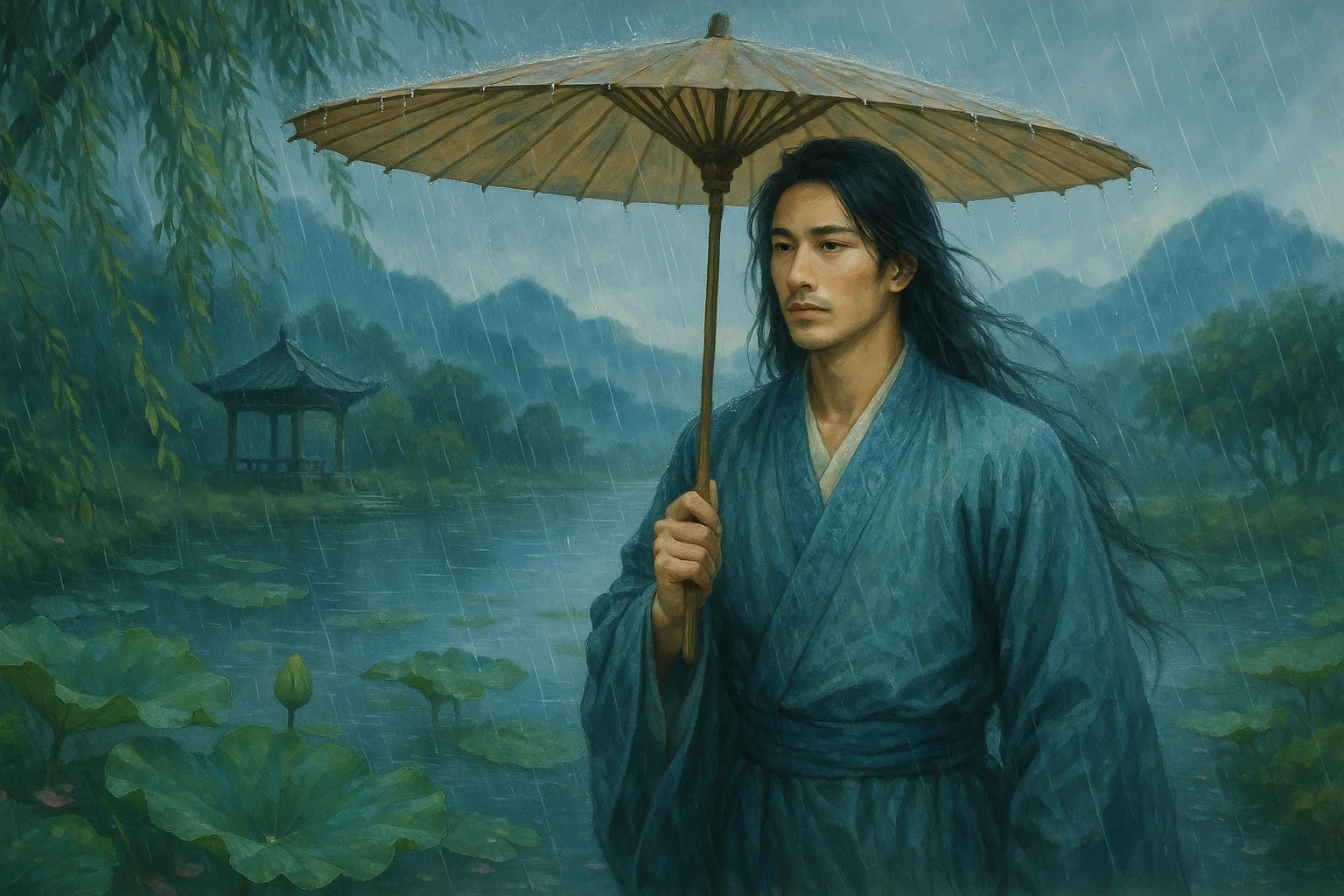
Lü Benzhong (吕本中 1084 - 1145), a native of Shouxian in Anhui, was a renowned poet and Neo-Confucian scholar of the Southern Song Dynasty. As a key theorist of the Jiangxi Poetry School, he proposed the concept of "living method" (huofa), advocating for natural variation within established poetic rules. With over 1,270 surviving poems, his Genealogy of the Jiangxi Poetry School (Jiangxi Shishe Zongpai Tu) established Huang Tingjian as the school's patriarch, profoundly influencing Song poetic theory and serving as a bridge between the Jiangxi School and the Four Masters of the Mid-Song Revival.







